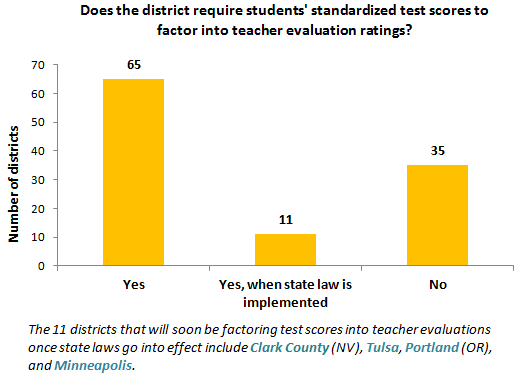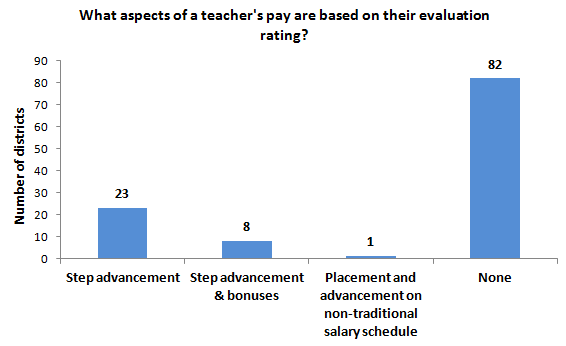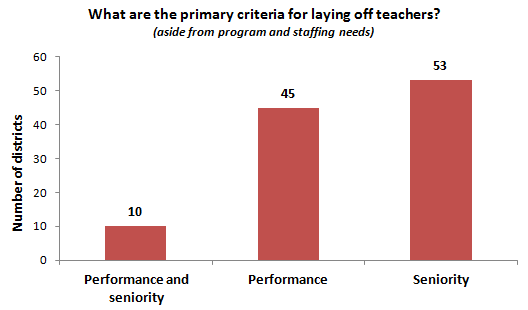November 2013
Welcome to NCTQ’s newly re-named Teacher Trendline newsletter (subscribe here). A special shout-out goes to the
anonymous survey respondent who proposed the new name.
This month we look at how school districts incorporate teacher performance
into personnel decisions. We’ve seen a lot of movement in this policy area
since we took stock of it a year ago. Here are the latest numbers on how districts are using teacher
performance to determine evaluation ratings, pay and the order of layoffs.
65 of
the 111 districts for which we have data currently require students’
standardized test scores to factor into teacher evaluation ratings. Another 11
will do so in the next few years when new state laws go into effect.
The vast majority of districts that include student test scores in
teacher evaluations require (or will require) that 50% of a teacher’s
evaluation rating be based on some form of student achievement data. No
districts base their student achievement data on standardized test scores
alone.

(click
here for source
data)
We’ve seen a big push for school districts to factor student achievement
measures into teacher evaluation ratings, largely because of mandates in new
state laws. The number of states with such laws jumped from 15 in 2009, to 30
in 2012, to 41 today (see our recent report Connect the Dots for details). Only
two school districts in the NCTQ Teacher Contract Database look at test scores
when evaluating teachers without state laws requiring them to do so: Los Angeles (for the first time in
2013-14) and Houston.
Just
under a third of the districts we track tie step advancement to teachers’ evaluation
ratings, with eight of those districts also awarding bonuses based on ratings.
There is only one district–Harrison County
(CO)–in which teacher pay is based solely on performance instead of years of
experience, advanced degrees and other factors. Teachers are placed and
advance on the nine-level, non-traditional pay scale according to their
summative evaluation and student achievement data.

(click
here for source
data)
When we looked at the relationship between teacher pay and performance a
year ago, we knew of only a handful of districts that tied step advancement on
traditional salary schedules to evaluation ratings. Now we know of 31 districts
that do this. Some of these policies are driven by state laws, such as those in
Florida, Indiana, Louisiana, and Utah. But many districts, such as Denver, Boston,
St. Paul, Newark,
Dallas, and Cobb
County and Fulton County
in Georgia, are all doing this without a mandate from the state.
The eight districts that tie bonuses as well as step advancement to
evaluation ratings are Douglas County
(CO), Newark, Denver, D.C.,
and Caddo Parish, Jefferson Parish, East
Baton Rouge Parish, and the Louisiana
Recovery School District in Louisiana. The bonuses in the Louisiana
districts are all nominal ($600 or less), but in Newark they go up to $12,500
and in D.C. they reach $25,000.
In 45
of the 108 districts for which we have data, performance is the primary
criterion for laying off tenured teachers. In another 10 districts both
performance and seniority are considered.
The large number
of districts requiring that layoffs be done primarily by performance is driven
by the 18 states (up from 15 in 2011) that require layoff decisions to be based
on teacher performance. Six districts–Mesa (AZ), D.C.,
Meridian (ID), Wichita,
Jackson (MS), and Wake
County (NC)–conduct layoffs by performance even though state law
doesn’t require it.

(click
here for source
data)
—
The Teacher Trendline is NCTQ’s monthly newsletter
designed just for school district officials (subscribe here). Each month we use data from NCTQ’s Teacher Contract Database to highlight the latest trends in
school district policies and collective bargaining agreements nationwide. The database contains teacher policies from
114 school districts, including the 50 largest districts, the largest district
in each state, Broad Prize winners, Gates investment districts and members of
the Council of the Great City Schools. Teacher
policies from all 50 states are also included. Send feedback to nwaymack@nctq.org.
More like this

Eight ways states can act now to retain an effective, diverse teacher workforce

Do state collective bargaining rules influence district teacher policies?


